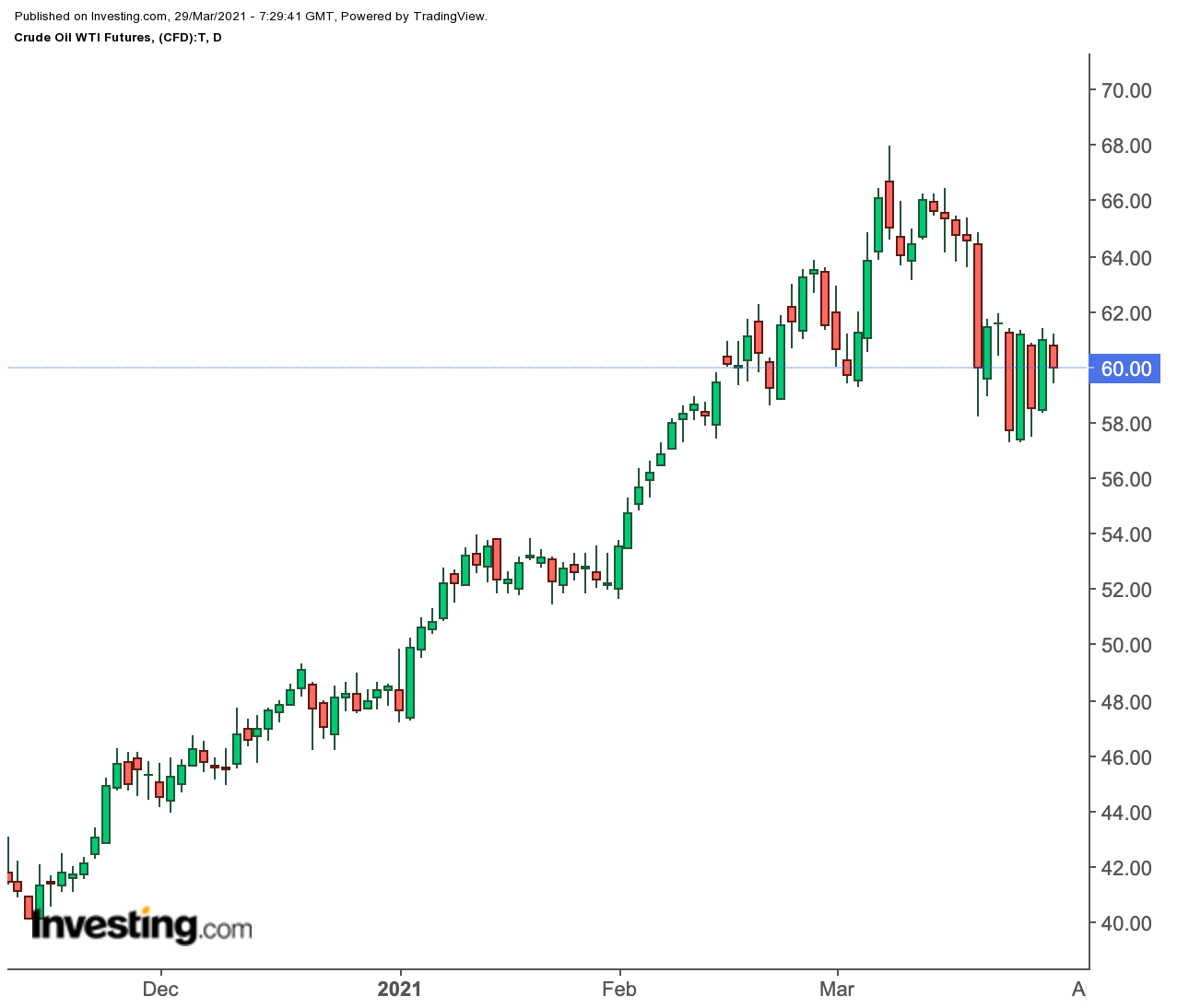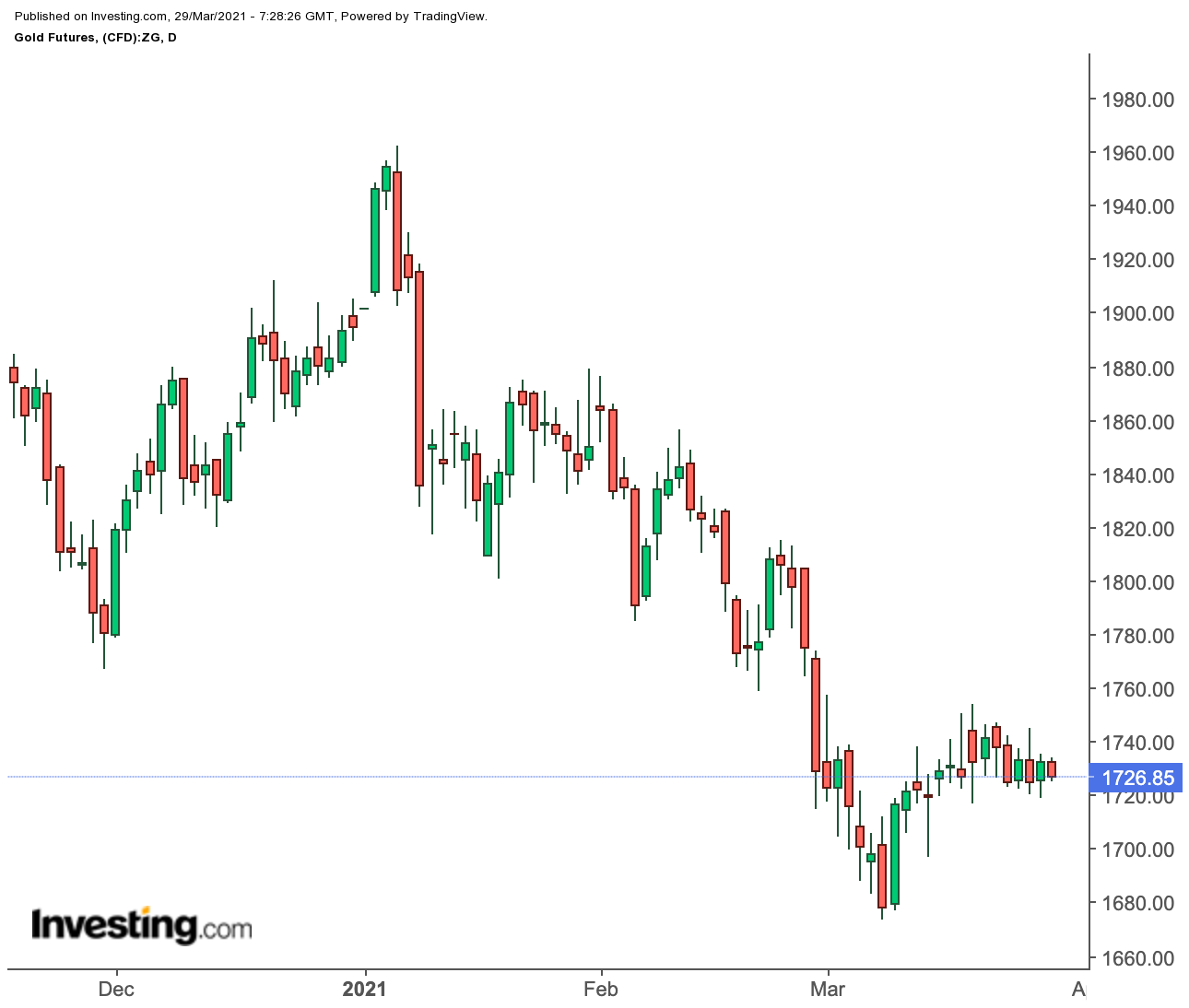The big question in oil is who’ll win as this week closes: the bears or OPEC+?
The 13-member Organization of the Petroleum Exporting Countries and its ten non-member allies—collectively known as OPEC+—won this year’s first two rounds when it managed to surprise short sellers in oil, first with a deep output cut for February-March, then with its pledge to withhold that until April.
Those two rounds produced an extraordinary win for the producer alliance. US crude benchmark West Texas Intermediate and UK-based global oil gauge Brent both jumped around 40% between Jan. 4 (a day before the first OPEC+ meeting of 2021) and Mar. 8 (the peak reached after the second meeting on Mar. 4).

But since those highs, both benchmarks have given back 10% of their gains in just 10 days.
Now, as the third OPEC+ meeting looms on Apr. 1, bets are on the alliance to once again withhold an output hike for May; maybe even double down with a cut.
If history is a guide, then this round should go to the alliance too.
Yet, if the recent volatility in crude holds any relevance—and it should by any measure—then there’s every chance that crude prices will take a renewed dip—even plunge—this week.
With The Suez Canal Unblocked, Oil Has One Less Reason To Rally
There’s good reason to suspect the price swings of the past 10 days in oil are not over. With the Ever Given container tanker finally freed from the Suez Canal after blocking one of the most important paths for crude shipments for almost a week, oil prices have one less reason to rally.
The recent swings in oil moreover have been uncharacteristic for a market that in the four previous months went almost in one direction—up. The roller-coaster ride began on Mar. 18 with a 7% plunge that was partially recovered in the next two sessions. Since Tuesday though, the market has gyrated like a yoyo, falling 6% and recovering nearly all of that on Wednesday; then taking another 4% tumble on Thursday, before recouping almost the entire lot by Friday.
By 1:30 AM ET (05:30 GMT) on Monday though, WTI hovered at just under $60 per barrel, down 2.3% on the day. On Mar. 8, it hit a high of almost $68, rising from an Oct. 30 low of just under $36.
Brent’s latest trade was just above $63 per barrel, down 2.2%. On Mar. 8, it hit peaks of just above $71, rising from a low of around $38 on Oct. 30.
The end-October to mid-March rally in oil was driven by OPEC+ production cuts and optimism over economic reopenings from COVID-19 lockdowns, driven by the global vaccination drive against the virus.
Since April, the 23-nation OPEC+ has withheld between nine and seven million barrels per day of supply from the market.
The most critical component of the OPEC+ cuts has been the Saudi portion—which has accounted for anywhere between one and two million barrels per day since April.
In January, when oil bears were betting on the alliance hiking production amid signs of strengthening demand, the Saudis doubled down with an additional one million-barrel cut for February and March, sending crude prices soaring. Saudi Oil Minister Abdulaziz bin Salman had boasted then that he would make life "hell" for short-sellers in oil.
When OPEC+ met again earlier this month to decide on April production levels, the Saudis again announced a one million-barrel cut for next month instead of a production hike. The difference, though, was the tone of Oil Minister Abdulaziz, who seemed genuinely concerned about demand.
In this week’s meeting for May quotas, the smart money is on the Saudis trying to clamp down on output again.
OPEC+ Will Find It Hard to Surprise
But some—like John Kilduff, partner at New York energy hedge fund Again Capital—think the kingdom’s propensity to surprise is over. Referring to Riyadh’s actions in the past two OPEC+ meetings, Kilduff explained:
“You do it once, it’s a surprise. Twice maybe. Third time? I wouldn’t think so. I think another cut is already baked into the cake and the market is beginning to get a little desensitized to the OPEC show.”
Jeffrey Halley, co-head of Asia-Pacific research for online broker OANDA, concurs with Kilduff that the chance of an OPEC+ production hike—the only thing that could surprise the market, given the circumstances—was virtually nil:
“With Asian importers on refinery maintenance cycles and content to use oil in storage, no solace is likely for oil prices from that direction this week. In this scenario, OPEC+ has almost zero chance of loosening the production cut targets. Of course, OPEC+ has surprised us before, but that is tilted towards supporting prices, and not forcing them lower.”
Oil Swings, Particularly To Downside, Likely To Continue
Halley also believes the market swings seen over the last 10 days in oil will continue, with a bias to the downside. He bases his assumption on how the market sank on Monday on news that the Ever Given tanker had been refloated from where it had run aground in the Suez Canal.
“If the Suez Canal situation is correct, oil’s recovery pre-OPEC+ may well be over. Given the volatility (of) last week, Brent looks set to move to the lower end of its $60 to $65 a barrel range. Similarly, WTI is likely to drop to the lower side of its $57.50 to $62.50 a barrel weekly range.”
Gold Continues With Target To Exceed $1,750
Gold, meanwhile, is expected to continue its positive-but-still-anemic run of the past two weeks as bulls try to find a way to break beyond the mid-$1,700 level that’s critical for a return to $1,800 pricing.

In last week’s trade, the gold price went through several hoops before settling at a slightly lower level than where it was a week ago. Most, importantly, the market did not crack the key ceiling of $1,750 per ounce, despite coming within less than $4 of meeting that test.
As is the norm, what stands in gold’s way are yields on the US 10-year Treasury note, which look likely to get beyond the 1.75% level next, and a Dollar Index that could set new 92 highs.
Both US gold futures and spot gold hovered at just under $1,730.
Long associated with tags such as safe-haven, store of value and inflation-hedge, gold has debunked such connotations for at least six months now, plunging particularly when market hype over inflation sent Treasury yields soaring instead.
The yellow metal demonstrated the faith placed on it by investors through the height of the pandemic, rising from March 2020 lows of under $1,500 to reach a record high of nearly $2,100. It has plunged since, briefly turning into a bear market early month when it lost as much 20% to hit lows under $1,675.
While gold has crawled out of that hole, it's been stuck under $1,750, behaving more like a patient on life support than one on the clear path to recovery.
Disclaimer: Barani Krishnan uses a range of views outside his own to bring diversity to his analysis of any market. For neutrality, he sometimes presents contrarian views and market variables. He does not hold a position in the commodities and securities he writes about.
